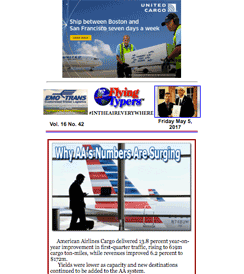

#INTHEAIREVERYWHERE
 |
 #INTHEAIREVERYWHERE |
| Vol. 16 No. 44 | Wednesday
May 17, 2017 |
Trump Effect Pt. 5: Who Will Pilot The Airline Business? |
After
100+ days, President Trump is
still focused on his campaign
promises to provide the U.S. with
security, GNP growth, and improved
infrastructure. Growth & Challenges
As I have suggested in my past
articles, these policies will
help to grow the U.S. airline
industry, but this growth will
create secondary problems, among
which are the need for improved
and increased airport infrastructure
and more pilots. The Pilot Crunch
Both military and aviation industry
experts have long predicted, even
based on the existing trends and
policies, that U.S. aviation would
face a serious shortage of trained
and qualified pilots. U.S. Commercials Move
As a result, the U.S. commercial
airlines have incentivized military
pilots to leave early to join
the commercial airlines and this
has become a national issue. Pilot Turnover Accelerates
Due to the aging of the current
commercial pool of trained and
qualified pilots, it is estimated
that approximately 45,000 out
of 153,000 U.S. airline pilots
will reach mandatory retirement
age in the next five years. High Costs, No Seed Incentives
One of the major contributing
problems is the high costs of
training U.S. non-military pilots
has shifted over time from employers
onto perspective learners, who
must often personally finance
education costs, in many cases,
over $500,000 without any government
assistance.
Flight Time Exported Because of this, some 250-hour trained U.S. pilots opt to sign on to airlines in countries like China, Europe, and the Middle East, which also face pilot shortages but only require 250 hours of flight training and pay high compensation. Pilots For All Seasons
To make matters worse, the pressures
placed on the commercial airline
industry exacerbate the shortages
the U.S. military already faces. Filling Pilot Ranks From Military
The risk of the commercial airline
sector cannibalizing the capacity
of the U.S. military is real,
and the size of demand in the
commercial sector dwarfs any surplus
pilots the military trains, meaning
commercial recruitment of military
pilots will have a direct and
immediate impact on sustainment. No Other Choice?
If the commercial industry does
not develop ways to recruit and
train sufficient non-military
pilots and merely continues offering
military pilots huge incentives,
the military may have to resort
to appropriate actions to maintain
the force needed for national
defense.
To Read Part 1 of This
Series, Click Here |
If
You Missed Any Of The
Previous 3 Issues Of
FlyingTypers Access complete issue by clicking on issue icon or Access specific articles by clicking on article title |
||
 Vol. 16 No. 41 May Day At CNS Chuckles for May 2, 2017 M&G Cool Chain Solution Unmanned Conference Drones On |
 Vol. 16 No. 42 Why AA's Numbers Are Surging Chuckles for May 5, 2017 Always Gentleman Dave The Finale That Was Overheard At CNS Celebrate Cinco de Mayo |
|
Publisher-Geoffrey
Arend • Managing Editor-Flossie Arend • Film Editor-Ralph Arend • Special Assignments-Sabiha Arend, Emily Arend • Advertising Sales-Judy Miller |
|